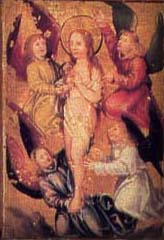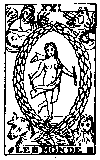 |
St Mary Magdalene (circa 1c A.D.) Disciple of Jesus. Mysterious beauty. Legends say Mary Magdalen was born to a noble family. Later she degenerated and became a prostitute. Meeting with Jesus brought repentance to her. Afterwards she devoted herself to meditative, contemplative life. She was the woman who was sister of Martha: who annointed Jesus at his tomb: whom risen Jesus first met and bade not to touch him. Many scholars consider the Magdalen legend consists of different women's stories. There is no reference to her in the Act. Many hypotheses have been put forward: some of them were labeled as heresy. Left: an attracitive, beautiful Mary Magdalene without any sign of repentance: painted by Crivelli (c1475). Attribute, a pot of ointment. |

